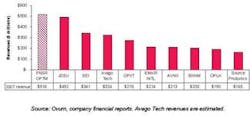MAY 19, 2008 By Stephen Hardy -- Friday's announced merger agreement between Finisar and Optium is getting rave reviews from the analyst community.
In comments issued today, Daryl Inniss, vice president, components research at Ovum, confirmed what the two companies proclaimed on Friday -- that the new Finisar will unseat JDSU as the largest optical components and subsystems supplier (see chart above). The combined entity also will have the "strongest" portfolio among Ovum's top 10 optical component (OC) suppliers in areas he considers high-growth: WSS-based ROADMs, 40-Gbit/sec line- and client-side transponders, 10-Gbit/sec tunable transponders, DWDM XFP transceivers, short-reach transceivers for 8 and 10 Gbits/sec, parallel optics and active cable, and active components for broadband access (PON and CATV). Inniss says that the two companies already derive "substantial" revenue from 10-Gbit/sec tunable transponders, DWDM XFPs, 8- and 10-Gbit/sec short-reach transceivers, parallel optics, and CATV components, while products are in development or ramping toward substantial revenues in the next 12 to 18 months in four other areas he did not name. (However, the companies are known to be working on ROADM technology, 40-Gbit/sec transponders, active optical cable, and PON components.)
"None of the other top 10 suppliers is in such a good position to grow for the next year or so. Furthermore, organic growth alone is unlikely to put the other OC suppliers in as competitive a position," Inniss notes.
Therefore, it's not surprising that Inniss likes the deal. "This is a positive deal for Finisar, although the discussion thus far has been mostly about the impact of the transaction on the rest of the OC market," he says. "Both Finisar and Optium were focused on manufacturing as a differentiator: Finisar from the perspective of high volume and low cost, and Optium with a radically different view of automation and customization to rapidly meet customer needs. Interestingly, the market needs both approaches. We have been favorably impressed with Optium's ability to successfully run a fabless business and produce gross margins around 30%.
The financial community also gave the proposed merger its stamp of approval. Paul Bonenfant, communications components analyst at Morgan Keegan, wrote in a note issued today, "We like the deal, and given market reaction think investors do, too. In general, investors have been clamoring for consolidation in the optical components space, and while unexpected we think this combination makes sense with virtually no product overlap and potential for revenue synergies in a shared customer base."
Bonenfant sees some product overlap in 10-Gbit/sec XFPs and client-side 40-Gbit/sec modules (two areas conceded by the principals on Friday), as well as ROADM technology given Optium's purchase of Engana and Finisar's recent investment in Nistica (search for Nistica).
"The combined companies' competitive positioning is strong with only JDSU having the breadth of products (and more) to compare favorably to the new combination, with overlap in JDSU's transmission (transceivers, transponders) and transport (optical switching/ROADM, optical amplifiers (OAs), and to a much lesser extent its integrated photonics (optical chip technologies and passive optical components) divisions within its Optical Communications (OptComm) business unit," Bonenfant wrote in assessing the combined company's competitive position. "Opnext has a competitive offering across its transceiver and transponder products lines, and similarly lacks exposure to OAs and passive components, but also lacks a ROADM play."
Bonenfant maintained his "Outperform" rating and said his company would continue to recommend Finisar on a standalone basis, noting he could see the stock worth nearly $3.00 per share, double its current valuation.
Meanwhile, John Harmon, vice president, equity research at Needham & Co. also gave a thumbs up. "Given Finisar's intention to move into telecom, we think the merger makes great sense by improving profitability and eliminating the enormous need to develop products that Optium already has," he wrote in a note to investors. Harmon, who had already rated Finisar as a "Buy," raised FY08 revenue and EPS estimates to $444 million and $0.07 from $432 million and $0.06; he also raised FY09 estimates to $512 million and $0.14 from $498 million and $0.13.
"Perhaps is the greatest benefit of the merger is R&D savings," Harmon commented. "Finisar has long been public about its intention to move into telecom optics, which would have required heavy R&D expenditures. The combined company will have shipping telecom products and ought to be able to spend a smaller percentage of sales on R&D than both companies together."
Harmon also expressed the hope that the merger would trigger significant consolidation within the optical communications component and subsystem space. Inniss echoed that sentiment, saying, "OC vendors must use consolidation and partnerships to remain competitive." However, while calling on JDSU to use such methods to enter the PON market and suggesting that Opnext needs to make a move into ROADMs, Inniss went on to say that he doesn't expect such major players as Sumitomo Electric Industries, Avago Technologies, Source Photonics, or Oplink to participate in the near future. Inniss called Bookham and Avanex the most likely acquisition targets.
For analysis and background from the chief executives of Finisar and Optium, visit the Lightwave Blog
